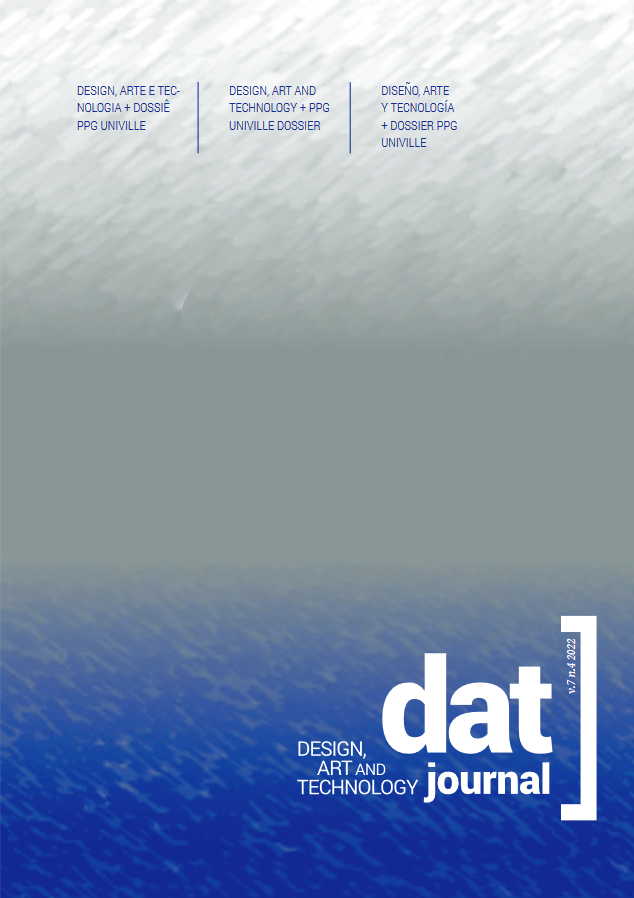O design centrado no ser humano e os desafios para a interação humano-computador a partir da ISO 9241-210:2019
DOI:
https://doi.org/10.29147/datjournal.v7i4.559Palavras-chave:
Design Centrado no Ser Humano , Interação Humano-Sistema, Experiência do Usúario , Design UniversalResumo
A ISO 9241-210:2019 representa o estado de arte da abordagem do design centrado no ser humano. Este artigo apresenta o resultado da análise das mudanças na abordagem da ISO sobre as atividades de design centrado no ser humano, fornecendo subsídios para compreender os desafios contem-porâneos no campo do design. Na análise do discurso da série histórica – ISO 13407:1999, ISO 9241-210:2010, e ISO 9241-210:2019 –, concluímos que existe uma relação estreita entre o design da interação humano-sistema, como tra-tado no documento, e, respectivamente, os princípios dos fatores humanos/ergonomia (1999), a experiência do usuário (2010) e o design universal (2019). Em razão de aceleradas mudanças sociais e ambientais e do avanço tecnoló-gico constante, o padrão para design da interação humano-sistema da ISO deve ser entendido mais como matriz do que paradigma para projetos que busquem alinhamento aos desafios que estarão no ponto cego da norma até a sua próxima atualização.
Downloads
Referências
BARANAUSKAS, M. C. C.; ROCHA, H. V. Design e Avaliação de Interfaces Humano-Computador. Campinas, SP: Univ. Est. de Campinas, 2003. Disponível em: https://www.nied.unicamp.br/biblioteca/design-e-avaliacao-de-interfaces-humano-computador/. Acesso: fev. 2021.
BENJAMIN, W. Magia e Técnica, Arte e Política. [Tradução de Paulo Sérgio Rouanet]. Obras Escolhidas; v. I. São Paulo: Brasiliense, 1987. BONSIEPE, G. Design: do material ao digital. Florianópolis: FIESC/SENAI/IEL, 1997.
BONSIEPE. Design como prática de projeto. São Paulo: Blucher, 2012.
CABRAL, A., VENTURELLI, S., & PRADO, G. (2019). Sinais detectados entre o biológico e o maquínico. DAT Journal, 4(3), 117–127. https://doi.org/10.29147/dat.v4i3.152 DOI: https://doi.org/10.29147/dat.v4i3.152
CARDOSO, R. Uma introdução à história do design. São Paulo: Edgard Blücher, 2000.
BONSIEPE. Design para um mundo complexo. Editora Ubu, 2011.
COSTA, C. “Professores da USP analisam os 100 anos da Bauhaus”. Jornal da USP. 2019. Disponível em: https://jornal.usp.br/?p=235410. Acesso: fev. 2021.
DI RUSSO, S. “Understanding the behaviour of design thinking in complex environments” (Tese). Pós-graduação em Design. Swinburne University of Technology, Melbourne, 2016.
FASTE, H. “Posthuman-Centered Design”. In: Digital Design Theory: Readings from the field. (Org.) ARMSTRONG, H. Princeton Architectural Press, New York, p. 134-137. 2016
FORLANO, L. “Posthumanism and Design”. She Ji: The Journal of Design, Economics, and Innovation, Volume 3, Issue 1, p. 16-29. 2017. DOI: https://doi.org/10.1016/j.sheji.2017.08.001
GARCIA, L. et al. “Projeto Centrado no Ser Humano: um panorama bibliométrico com base na Science Direct”. Revista Brasileira de Design da Informação. São Paulo. v. 13 n. 1. p. 39-51. 2016. DOI: https://doi.org/10.51358/id.v13i1.409
GIACOMIN, J. What is Human Centred Design? In: P&D Design 2012. 10º Congresso Brasileiro de Pesquisa e Desenvolvimento em Design, São Luís (MA), 2014.
HESKETT, J. Desenho Industrial. José Olympio; 2ª ed., 1998.
ISO 13407. Human-Centred Design process for interactive systems. Genève: ISO, 1999.
ISO 9241-11. Ergonomics of human-system interaction — Usability: Definitions and concepts. Genève: ISO, 2018.
ISO 9241-210. Ergonomics of human-system interaction — Human-centred design for interactive systems. Genève: ISO, 2010.
ISO 9241-210. Ergonomics of human-system interaction — Human-centred design for interactive systems. Genève: ISO, 2019.
ISO. Contributing to the UN Sustainable Development Goals with ISO standards. Genève: ISO, 2018.
ISO 9241-210. Contributing to the UN Sustainable Development Goals with ISO standards - Committee ISO/TC 159/SC 4 - Ergonomics of human-system interaction. Genève: ISO, 2021. Disponível em: https://www.iso.org/committee/53372.html. Acesso em 14.02.2021.
ISO 9241-210. Friendship among equals: recollections from ISO’s first fifty years. Genève: ISO, 1997.
JENKINS. H. Cultura da convergência. São Paulo: Aleph, 2009.
KRIPPENDORF, K. “Propositions of Human-centeredness: A philosophy for design.” In: DURLING, D.; FRIEDMAN, K. (Eds.) Doctoral Education in Design: Foundations for the future. Staffordshire University Press, 2000.
LÖBACH, B. Design Industrial. Bases para a configuração dos produtos industriais. 1ed. São Paulo: Edgard Blücher, 2001.
MACE, R. et. al. Accessible environment: Toward Universal Design. The Center for Universal Design. NC State University. 1991. Disponível em: https://projects.ncsu.edu/ncsu/design/cud/pubs_p/docs/ACC%20Environments.pdf. Acesso: fev.2021
MARCON, M. P., VENTURELLI, S. (2021) Apropriação das mídias sociais interativas como suporte na elaboração de contextos de aprendizagem em tempos de pandemia. DAT Journal 6(3), 39-55. HTTPS://https://doi.org/10.29147/dat.v6i3.436. DOI: https://doi.org/10.29147/dat.v6i3.436
MOZOTA, B. Design and competitive edge. London: Academic Review, Design Management Journal, 2002.
NORMAN, D. A.; DRAPER, S. W. User-centered system design: New perspectives on human-computer interaction. Hillsdale, NJ: Lawrence Erlbaum, 1986. DOI: https://doi.org/10.1201/b15703
NORMAN, D. A. O design do dia-a-dia. Anfiteatro. 2018a. E-book Kindle.
NORMAN, D. A. “The Future of Design: When you come to a fork in the road, take it”. 2018b. Disponível em: www.jnd.org/the_future_of_design_when_you_come_to_a_fork_in_ the_road_take_it Acesso: fev. 2021.
ONU. “Convention on the Rights of Persons with Disabilities”. Article 4 – General obligations. 2008. Disponível em: www.un.org/development/desa/disabilities/convention-on-the-rights-of-persons-with-disabilities/article-4-general-obligations.html. Acesso: fev. 2021.
ONU. “Transforming our world: The 2030 agenda for sustainable development.” 2015. Disponível em: www.sdgs.un.org/sites/default/files/publications/21252030%20Agenda%20for%20Sustainable%20Development%20web.pdf. Acesso: fev. 2021.
PREECE, J. et. al. Design de Interação: Além da Interação Humano-Computador. Porto Alegre: Bookman, 2005.
ROSA, et. al. Neurodesign - O cérebro e a máquina. Rio de Janeiro, RJ: Rio Book’s, 2016.
STEPHANIDIS, C. et. al. Seven HCI Grand Challenges, International Journal of Human-Computer Interaction, 35:14, p. 1229-1269. 2019. DOI: https://doi.org/10.1080/10447318.2019.1619259
Downloads
Publicado
Como Citar
Edição
Seção
Licença
Copyright (c) 2022 DAT Journal

Este trabalho está licenciado sob uma licença Creative Commons Attribution 4.0 International License.


























